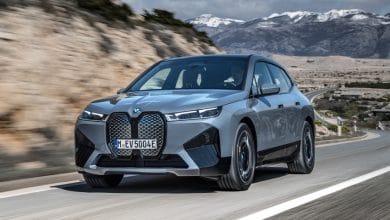Contents
Its design

PHOTO PROVIDED BY MERCEDES-BENZ
The 2024 Mercedes-AMG GT Coupe
Visually, the work reassures by basing its eloquence on the fundamentals of a sports coupe. Its long front hood remains the pièce de résistance. The very low grille hugs the ground and exposes its belonging to AMG, with its vertical rods. The descending headlights, fixed on the wide wings, complete a fighting face. The side plan reveals an increased length of 171 mm in comparison with its predecessor. But it is above all the roof line that flatters the eye with its magnificent ascending line above the passenger compartment which falls on the hatchback trunk. The curved rear is just as sculptural with its thin triple-line lights and the use of a retractable spoiler to preserve a smooth appearance.
On board

PHOTO PROVIDED BY MERCEDES-BENZ
The dashboard of the 2024 Mercedes-AMG GT Coupe
The layout of the cabin is resolutely the latest generation of Mercedes-Benz. The emphasis is on technology with the huge central vertical screen, necessary for almost all the usual controls. The assembly remains elegantly tied together with abundant leather bordered by a beautiful wealth of materials ranging from carbon fiber to aluminum, or even wood, if you wish. The ventilation nozzles, presented in the form of turbines, are pretty in addition to ensuring precise adjustment. Unlike many sports cars, this GT respects its label of grand tourer with its very welcoming cabin for its passengers. It is also practical with its rear storage and its large but narrow trunk.
Under the hood

PHOTO PROVIDED BY MERCEDES-BENZ
The 2024 Mercedes-AMG GT Coupe's 4.0-liter twin-turbo V8
What would the Mercedes-Benz sports flagship be without a V8? A brand specialty, this configuration remains under the hood of the GT with a measured displacement (4 L) and two turbochargers. Producing 577 hp in its GT 63 livery, its music is furious and heavy. The usual detonations smash against the walls of buildings, nothing too delicate. The theatricality of the assistance at the launched start is also fascinating. The engine mapping then sets the turbos in rotation, letting out a heavy and rhythmic growl. All you have to do is release the brake pedal to be catapulted, glued to the seat back, shaken by frank gear changes. The horizon blurs, the car remains supremely stable.
Behind the wheel

PHOTO PROVIDED BY MERCEDES-BENZ
The 2024 Mercedes-AMG GT Coupe
More dynamic, this GT has gained 355 kg. At nearly 2000 kg in total, it is heavy, very heavy. Its all-wheel drive partly explains this weight gain, making its traction exemplary and predictable. At the rear, there are directional wheels that support agility, but the weight is noticeable when cornering when the car negotiates bumps. The coupe nevertheless sits confidently, stopping roll when cornering by means of a hydraulic system. The steering is precise, but the communicative aspect could be more complete. The damping ensures a good level of comfort, but there is a noticeable excessive dryness on transverse crevices. Cracking noises then emanate from the moldings making up the passenger compartment.
Embedded technologies

PHOTO PROVIDED BY MERCEDES-BENZ
Like many modern vehicles, the GT has a touchscreen that controls many elements of the car.
The GT places a strong emphasis on the technological aspect of its offering, an approach strongly advocated by the brand. The 11.9-inch vertical screen captures attention with its high definition. It is also the touchscreen gateway to the MBUX system, whose approach requires too many steps to reach commonly used menus, and its tabs do not always point to the elements you want. The heating and air conditioning controls, however, remain accessible from the bottom. And the controversial haptic controls on the steering wheel become intuitive after a necessary learning curve. Mercedes-Benz has fortunately integrated configurable dials on the steering wheel for driving settings.
The verdict

PHOTO PROVIDED BY MERCEDES-BENZ
The 2024 Mercedes-AMG GT Coupe
Once considered the ultimate celebration of automotive design, the coupe is increasingly rare in this sea of undifferentiated SUVs. Let's applaud Mercedes-Benz's initiative to renew the GT. Fundamentally, the sports car is more versatile and cautious. In this sense, it loses some of its uniqueness to appeal to a broader audience, which makes us wonder what it's really trying to accomplish. The vocal and torquey V8 remains a formidable argument that adds a more visceral layer to driving this GT, despite a nine-speed transmission that lacks consistency in downshifting. A very beautiful and expensive object, whose complexity is probably a mirror of our times.
Notebook
Aerodynamics studied
To keep the car stable even at its top speed of 315 km/h, engineers employ a rear spoiler that can continuously adjust its angle, as well as controlling the airflow under the car by adjusting the ride height.
Powerful braking
This Mercedes-AMG GT also features a powerful optional four-wheel carbon-ceramic braking system with six-piston front calipers doing most of the work, along with 15.4-inch discs. The pedal has good progressiveness under hard braking.
If you don't like your passengers
This coupe can be ordered with two additional rear seats, a $2,500 option that is not really useful due to the extremely tight space.
A plug-in hybrid that rocks
An 805 hp plug-in hybrid version will soon be available. It will be able to go from 0 to 100 km/h in just 2.8 seconds, compared to 3.2 seconds for the GT 63 version tested.
To avoid snagging your feet
The manufacturer offers the GT with a system that allows the front of the vehicle to be raised in order to avoid costly repairs due to the long overhang. A good idea on paper, which nevertheless takes a long time to activate.
Technical sheet
- Version tested: GT 63 Coupé
- Price (with options): $233,035 (starting price $195,000)
- Engine: 4.0L V8 DOHC twin-turbo
- Power: 577 hp from 5500 to 6500 rpm
- Torque: 590 lb-ft from 2500 to 5000 rpm
- Transmission: 9-speed automatic with manual mode
- Powertrain architecture: longitudinal front engine, all-wheel drive
- Consumption (EnerGuide): 15 L/100 km (Super gasoline)
- Competitors: BMW 8 Series, Chevrolet Corvette, Maserati GranTurismo, Porsche 911
- What's new in 2024? New generation (the second)












